March Has One Last Laugh At Golfers In Michigan After a week of mid fifties ... Read more.
The post March Has One Last Laugh At Golfers In Michigan appeared first on GolfBlogger Golf Blog.
from GolfBlogger Golf Blog https://ift.tt/2ODsoqO
March Has One Last Laugh At Golfers In Michigan After a week of mid fifties ... Read more.
The post March Has One Last Laugh At Golfers In Michigan appeared first on GolfBlogger Golf Blog.
Golf Door Mat Ridiculous Golf Item of the Week
The post Golf Door Mat appeared first on GolfBlogger Golf Blog.
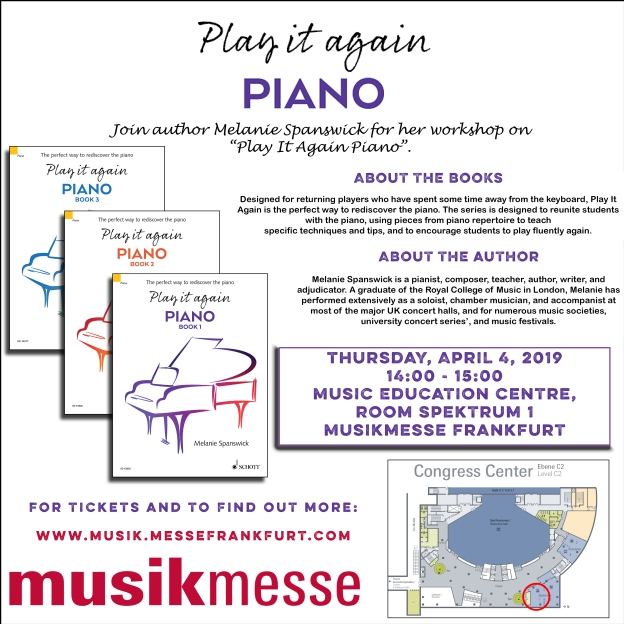 I’m really looking forward to giving a presentation and workshop at this year’s Frankfurt Music Fair or Musikmesse which takes place from April 2nd – 5th. My workshop will be held on Thursday April 4th at 2.00pm. This presentation focuses on Play it again: PIANO Book 1, 2 and 3. Book 3 will be officially launched next week at the Fair, after which I’ll add links as to where it can be purchased for those of you who have kindly enquired.
I’m really looking forward to giving a presentation and workshop at this year’s Frankfurt Music Fair or Musikmesse which takes place from April 2nd – 5th. My workshop will be held on Thursday April 4th at 2.00pm. This presentation focuses on Play it again: PIANO Book 1, 2 and 3. Book 3 will be officially launched next week at the Fair, after which I’ll add links as to where it can be purchased for those of you who have kindly enquired.
I very much enjoy giving workshops and presentations. They nearly always include references to my books, and this one will be no exception. I’ll start by speaking about all three books within my piano course, which, as many readers know, is intended for those returning to piano playing after a break. The workshop highlights the importance of developing physical flexibility in piano playing, with audience participation and some relaxation exercises too.
The new addition to the Play it again course, Book 3, begins where Book 2 stops. It takes students on a journey from Grade 8 to the Associate Diploma level, via the new Post Grade 8 Diploma. As a quick recap, Play it again Book 1 is approximately Grade 1 – 4 level, and Book 2, Grade 5 – 8. Each book contains a collection of pieces mostly selected from standard repertoire. There are twenty-eight pieces in Book 1, and twenty-one in Book 2.
Book 3 features eleven works by a variety of composers and genres, with copious practice notes for each piece (some pieces have up to 8 pages of notes). It’s possible to form a Post Grade 8 Diploma or Associate Diploma programme from this book. Book 3 will be on sale at the Frankfurt Fair, and I’ll be publishing a much more detailed survey of the book next week.
If you would like to attend my presentation, you can find more information here. I look forward to meeting you.
My publications:
For much more information about how to practice piano repertoire, take a look at my piano course, Play it again: PIANO (published by Schott Music). Covering a huge array of styles and genres, the course features a large collection of progressive, graded piano repertoire from approximately Grade 1 to advanced diploma level, with copious practice tips for every piece. A convenient and beneficial course for students of any age, with or without a teacher, and it can also be used alongside piano examination syllabuses too.
You can find out more about my other piano publications and compositions here.
I have been out to play twice this week in an effort to shake off ... Read more.
The post Shaking Off The Winter Golf Rust appeared first on GolfBlogger Golf Blog.
Earlier this year, my wife and I went on vacation to Mexico.
During our stay, we spent about 90% of our time sitting on the beach (and I burned to a crisp… but that's another story).
Now, sitting on the beach might sound like an easy thing to do (and it is, for the most part)… but there's one problem I have with sitting around all day.
I'm not a big fan of doing nothing.
My brain always needs to be engaged. Whether it's solving a problem, working on a deal, listening to a podcast, reading a book, etc.
I think most books have a ton of value, and it's a perfect activity for sitting on the beach… but the problem I have with reading books is – I'm a SUPER slow reader. Unless I'm intensely interested in the subject matter, I have a hard time spending ALL DAY consuming a single book.
RELATED: 20 Books That Changed My Life
Even audiobooks can be a struggle for me, because it can easily take 5 – 10 hours to get through one audiobook (not to mention, if I don't like the narrator, it can ruin the listening experience for me).
But get this… even with all these things working against me, in one day of sitting on the beach, I was able to get through 22 books.
How did I get through 22 books in one day? I used an app called Blinkist.
Note: This blog post is a not a paid endorsement of Blinkist. I just thought it was useful and wanted to share it with you.
 Blinkist is a huge library of non-fiction book summaries. In about 15 minutes, you can get a quick overview of all the key ideas and takeaways from each book.
Blinkist is a huge library of non-fiction book summaries. In about 15 minutes, you can get a quick overview of all the key ideas and takeaways from each book.
It’s like reading or listening to someone’s notes on a book. You'll see only the most important points (called “Blinks”) and nothing else.
For me, this is EXACTLY what I needed.
Being a real estate blogger, there are dozens and dozens of books on my list that have been recommended by friends, family and colleagues.
But as I mentioned – reading books isn't something I love to do for fun. I don't appreciate all the “fluff” that comes with most books. I’m looking for those small nuggets that are buried in the text. You know… those 5 pages of real value for every 150 pages of unnecessary narrative and filler content.
The harsh reality is, I'm never going to read the vast majority of books that are recommended to me… there just isn't enough time or desire to make it happen.
That's where Blinkist comes in. It's a great way to consume books that I'm mildly interested in (80% of books on my list), but will never make the time to read the long-form version of it.
 Blinkist is a designed as a mobile app, so you can take it with you wherever you go.
Blinkist is a designed as a mobile app, so you can take it with you wherever you go.
You can read each book summary from the screen of our mobile device or you can listen to it. Both mediums are very well-written and presented.
I consider myself sort of an “audiobook connoisseur”, because I've heard a lot of different audiobooks and voiceover artists over the years. Some of them are excellent and some of them are terrible – but of every Blinkist book I listened to, I thought every narrator was very good and easy to listen to (which is a huge part of the listening experience).
Just like most audiobook and podcast listening apps, you can choose to listen at faster speeds if you'd like to get through it quicker. But personally, I felt it was better to listen at normal speed, since it’s already easy to miss things in such a condensed format (and they're only 15 – 20 minutes to begin with, and there is basically zero fluff in these short summaries).
Now, there are some obvious drawbacks to reading a book through Blinkist rather than reading/listening to the original, unabridged version of a book.
If you're only willing to give a book 15 minutes of your time, you’re going to miss out on a sizable portion of the value you would've gotten had you given the book all of your time. If you choose to “read” a book through Blinkist, don't expect to get the full experience the author intended.
Blinkist's greatest strength is also its greatest weakness. It’s a nice all-you-can-eat, buffet-style way to read lots of books in a short timespan, but don’t expect as rich of an experience when you're not willing to fully immerse yourself in a book.
Another thing I learned pretty quickly from Blinkist is that you need to stay engaged. DON'T zone out while you're reading or listening to these “blinks”.
It’s okay to zone in-and-out of most long-form books, because the value is spread out and a bit more watered down, but not with Blinkist. If you miss 60 seconds, you’ll miss a HUGE chunk of what the book is all about.
After using Blinkist for a couple of days, I was actually pleasantly surprised by a few things from it.
If you're anything like me, you've probably started listening to an audiobook before, but you had to abandon it midway through.
There are a number of full-length audiobooks I’ve completely given up on, either because the narrator was too annoying or because I couldn’t stick with it and pay attention. Some books are just WAY longer (and more boring) than they need to be.
However, when I listened to the Blinkist versions of these same books, it breathed new life into them for me. I finally saw the value in the author's message when it was condensed into a smaller, bite-sized format and fed to me in a way that I had the capacity to digest. I didn't have to attention span to consume the unabridged version of these books, but Blinkist made them much more palatable.
Another funny thing I discovered when listening to the Blinkist version of How to Win Friends and Influence People by Dale Carnegie, I actually came away with new insights from the book that I never noticed back when I first read the unabridged version of the book years ago.
When you listen to someone else's takeaways from the same material, there's a good chance they'll interpret the information in a different way than you do – and that was another unexpected piece of value I got from Blinkist.
As I eluded to above – Blinkist isn't for everyone. If you're someone who NEEDS to experience the full, unabridged version of every book you read, then you probably won't appreciate what Blinkist has to offer.
If you're like me, however, and you don't have the time, desire or attention span to get through dozens of books every year…
If the alternative to reading books is to just NOT read books at all – then I think Blinkist can bring a huge amount of value to the table.
It's definitely not the same experience as reading through an entire book the old fashioned way, but if you want to get in on the action without completely missing out on all the value that non-fiction books have to offer, I think the value of Blinkist is easily worth many times more than it costs.
The post How I “Read” 22 Books In One Day (And You Can Too!) appeared first on REtipster.
The Indian Open first was played in 1964. The current sponsor is Hero, an Indian ... Read more.
The post Indian Open Winners And History appeared first on GolfBlogger Golf Blog.
Citizen Mickey Mouse Watch I am totally in love with this Citizen Mickey Mouse Watch. ... Read more.
The post Citizen Mickey Mouse Watch appeared first on GolfBlogger Golf Blog.
2019 KIA CLASSIC CELEBRATES 10 YEARS The LPGA Tour makes its second stop on the West Coast ... Read more.
The post LPGA Kia Classic Preview 2019 appeared first on GolfBlogger Golf Blog.
The Kia Classic has been a fixture on the LPGA Tour since 2010. The inaugural ... Read more.
The post LPGA Kia Classic Winners and History appeared first on GolfBlogger Golf Blog.
Amazon Essentials Classic Fit Stretch Golf Pant Amazon has gotten into the golf apparel business. ... Read more.
The post Amazon Essentials Classic Fit Stretch Golf Pant appeared first on GolfBlogger Golf Blog.

How did I become a successful travel blogger? It sure wasn’t intentional from the start! Back when I started Adventurous Kate in 2010, I had no idea it was even possible to make money with a blog.
Recently I read the book Outliers by Malcolm Gladwell, which explains how certain individuals became successful. People tend to believe that genius leads to success — for example, that Bill Gates became successful because he was so smart.
But that’s not all of it. Intelligence is a huge factor. So is hard work. But so is opportunity — whether it’s being born at the right time, having the right background, or spending years on a new hobby that eventually becomes a viable career.
Bill Gates was smart and worked hard, but he also had unlimited access to a computer lab as a teenager — something so unusual at the time it was almost unprecedented. This allowed him to get in far more computing practice than his peers, giving him nearly unmatched experience by the time he founded Microsoft.
After reading this, I began thinking of every event in my life that put me in a position to become a successful travel blogger. After a bit of thinking, it came into clear focus. It was being obsessed with an early social network that taught you how to build your own website. It was a professor identifying my potential during my first semester in college. It was getting one of the earliest jobs in social media for a travel company. It was moving to Europe at a time when the travel blogging industry was strongest in Europe. And far, FAR more.
When all of this information added up at once, I was flabbergasted.
When you look at my life, from my birth to today, not only is it unsurprising that I ended up in this career — it seems inevitable that I would eventually become a professional travel blogger.

I had awesome hair when I was born.
You can’t begin to examine my life without first acknowledging my privilege. I grew up white and Catholic in a middle-class community in Massachusetts with a good school system. I didn’t grow up anywhere close to wealthy, and my childhood was difficult in some ways, but I was overall in a very privileged position.
My life was never made more difficult due to my race, religion, sexuality, gender identity, economic background, or nationality. As a result, opportunities came more easily and frequently to me and I didn’t have to work as hard as most people.
It didn’t feel like it at the time, especially when I went to college and was surrounded by kids from obscenely wealthy families, but I now realize how my privilege set me up for success.

Girl reading book (via Pixabay)
From the moment I began school, I was expected to excel. This translated into being pushed to work as hard as possible and supplement my schoolwork with other activities, like piano lessons and constant reading. Drama and music were my main interests; I did sports but was never a skilled or enthusiastic athlete.
I couldn’t tell you when my geography fascination began — I can’t remember it ever not being there. All I know is that whenever I got my hands on a map, I would get lost in it. As soon as we were allowed to check out nonfiction books in school, I would make a beeline to the 900s section and choose a book about a different country every week.
I had a placemat with a world map on it. I was obsessed with it and my family would quiz me on countries every night. (My mom took a picture of me with the placemat the day I left to travel.)
What kind of kid was I? I was the kid who got in trouble for leaving her Ethiopia library book at her after-school Math Magic class. (God, I hated that class. I was the youngest kid and the only girl.)
Being pushed academically is what gave me my lifelong work ethic, and my love for geography eventually grew into a love for travel.
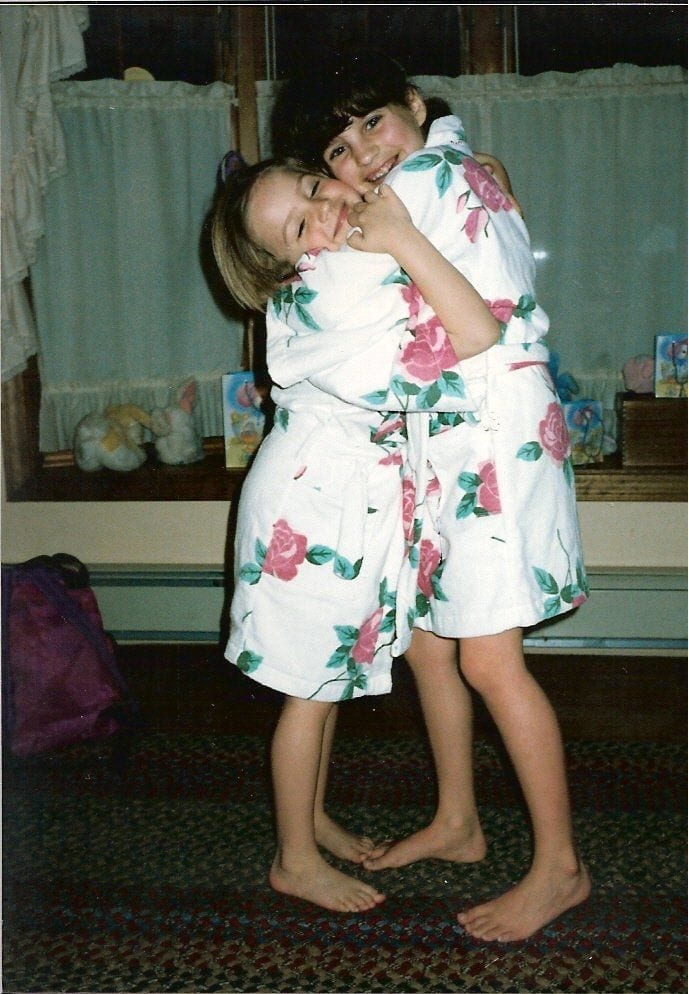
There’s a Jack Donaghy quote from 30 Rock that I love: “The first generation comes to this country and works their fingers to the bone. The second generation goes to college and creates new innovations…the third generation snowboards and takes improv classes.”
My family has been in the US for a long time, but I was a classic third generation kid. Both of my parents were the first people in their families to go to college. And both of them lost their fathers when they were teenagers, which meant that their mothers had to go to work, money was tight, and they had to pay for college themselves. They both commuted to state schools, chose “smart” career paths — business for Dad, teaching for Mom — and eventually earned graduate degrees.
My parents wanted me to have a childhood without constantly worrying about money. To be able to go to the best college for me and live on campus. To eventually have a career I loved.
This translated into a freedom to dream in a way that many of my friends couldn’t. My friends who grew up with immigrant families, or in conservative cultures, were more or less forced into medicine, law, or engineering from a young age, spending their time on extracurriculars that could lead to a better future.
I was told I could do anything, study anything, be anyone I wanted to be. I wholeheartedly believe that growing up with this mindset led me to quit my job, travel solo, start a business in a brand new industry, and live unconventionally.

My dad has always been interested in computers and technology; he passed on this excitement to me. On Christmas when I was six years old in 1990, I was led downstairs to see the latest addition to the family and I squealed, “It’s a computer! And it’s a Macintosh!”
That small, square, early 90s computer was the beginning of my love for technology. I was only playing games and creating art as a kid, but I was hooked. The computer was a million times more fun than anything else.
I grew up in the nascence of the internet and was immersed in its early days. My dad went on to train his colleagues in how to use the internet. Around the same time, we brought the 1990 computer to my fifth-grade classroom and I taught my teacher and classmates how to use it.
I was never interested in coding or the engineering side of computing. But growing up with computers, being comfortable with them, and constantly learning what they could do gave me an edge that came to fruition in high school.
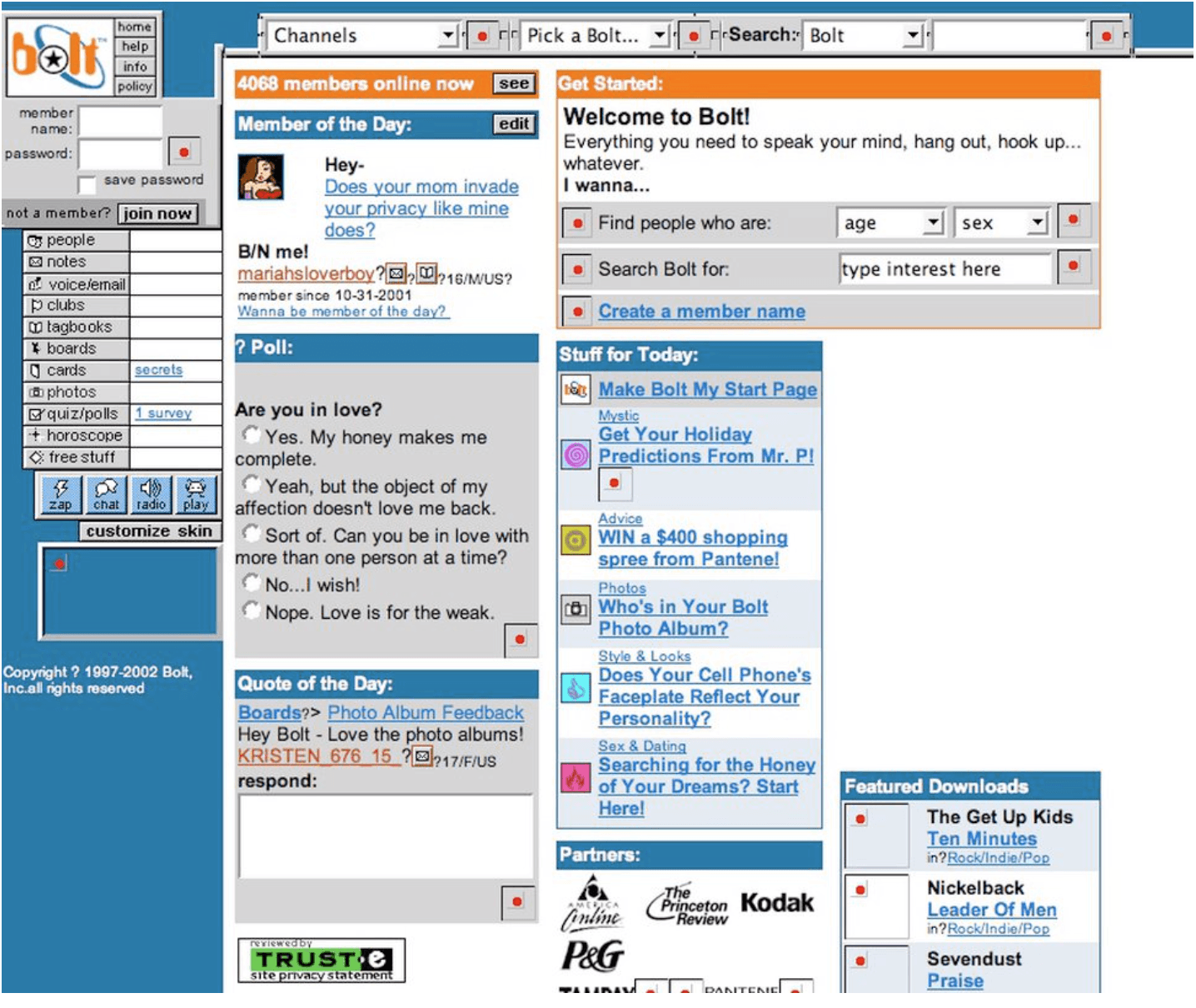
When I was around 13 in 1998 or so, I spent my time on a website called Bolt — it was one of the early social networks predating MySpace. They had message boards, quizzes, badges, private messaging. There were different sections for music, movies, sports, astrology. I was obsessed with Bolt and spent so much of my internet time on there.
And one thing you could do on Bolt was create your own website. I was fascinated and decided to build an astrology website.
It was simple — a home page with twelve links linking to separate pages for each astrological sign. On each sign’s page, I posted a description of the sign’s qualities. I copied and pasted the description from another site (holy plagiarism!).
I kept that simple site immaculate, though. It was neat and clean. Each page had a “go back home” link at the bottom. I spent time targeting the colors to each sign. It wasn’t overloaded with counters or 90s clipart.
But then Bolt featured the site on its astrology homepage. I was thrilled to high heaven. People were visiting a site I made!
For my second website, when I was 14, I turned to Angelfire and decided to build a fan site for my favorite Backstreet Boy, A.J. McLean. (Amusingly, 15 years later, I would learn that we are actually cousins.) I was already an expert on all things A.J. — this site would be a place to put it all together. I created pages with his biography, his favorite things, pictures of A.J., videos of A.J., his songwriting credits.
Angelfire was where I began teaching myself rudimentary HTML. I wasn’t hardcore coding or anything like that, but I loved learning the basics. More importantly, though, I was learning how to structure content in a way that would entertain readers.
My third site, also created at age 14, was definitely my most embarrassing site: a Backstreet Boys humor site called Out the Dizzo. Yes, a Backstreet Boys humor site. Around 1999, they were a thing and there were tons of them.
I would constantly create new content for the site: funny alternate lyrics to Backstreet Boys songs, funny quotes for Backstreet Boys pictures, links to the funniest Backstreet Boys fan fiction, and of course, commentary on “All I Have to Give: The Conversation Mix.” The name Out the Dizzo came from a random quote Kevin Richardson once gave in an interview that was an ongoing joke in our community.
My fourth site was my most professional site yet, and it served a purpose: it was called “Who’s Going Where” and I built it my senior year of high school as a directory showing where everyone was going to college. There were headings, there were colors, it was laid out professionally, and I was proud of it.
These days of building websites were absolutely blissful — I fell in love with it. But more importantly, when it became time to build a professional time, I wasn’t slowed down by learning HTML and how to structure content. I already had years of experience.

From an early age, I was a hardcore francophile, thanks to the influence of my French Canadian grandmother. She taught me basic French, gave me French books, and made me proud of my French heritage. I signed up to take French in the eighth grade; the vast majority of my classmates took Spanish.
Every other year, my high school did an exchange with a school in Rouen, France. Their students would come visit for two weeks in the fall and stay with our families, then we’d visit them in the spring. By the time I was a junior, I had been dreaming of this trip for years.
WHAT A TRIP. I felt such freedom traveling with my friends. I felt electrified when I spoke French and was understood. I got to know French culture while staying with a family in the countryside. My language skills improved rapidly thanks to the immersive environment. I took more photos than any normal human would. I saw so much of Normandy, from Etretat to Caen to Giverny. And I fell madly in love with Paris, a love that remains to this day.
I look back at that trip with fondness — but also with embarrassment. I got roped into paying for shitty portraits and bracelets woven on my wrist without my consent by men who approached me at Montmartre. (Looking back, I find it absurd that our teachers didn’t warn us about the Montmartre scam artists but made a big deal about the word “bagel” being code for pickpocket.) And our behavior at the Normandy battlefields was appalling — we called it “Teletubby land” and took goofy pictures.
But that first trip began everything. For the first time, my love of reading travel books and studying maps had grown into something more real. I was a traveler — and I was good at it.
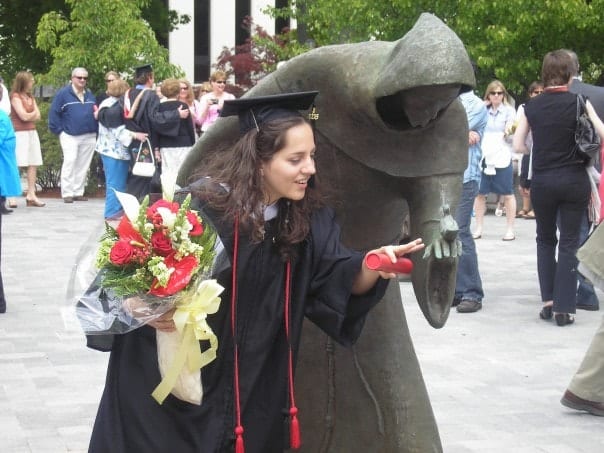
When I started college at Fairfield University, I planned to double-major in psychology and French — then I decided to keep my options open and go in undeclared. I’d chosen a Jesuit university because they force you to study so many different areas in depth; I wanted to learn about as many subjects as I could.
During my first semester of college, I took the introductory writing class required for all freshmen. Papers were due every week and I wrote them in a way I thought college writing was supposed to be: intellectual, distant, emotionless.
Then one week I was bored and decided to write an essay about how I loved to take on dares when I was in middle and high school. If someone dared me to do something crazy, I would do it. I had a blast writing about all the adventures resulting from my dares. If my professor hated the essay, I’d do something more normal the next week.
I got my paper back and the entire back page was covered in red pen. My professor had LOVED it. He himself loved to do silly things to make people laugh. “SEE ME!” It read at the bottom of the paper.
I went to see him after class and he raved about my paper, telling me how much he loved it and what a talented writer I was. He was expecting to see more great things from me in the English program.
“Do you think…I should major in English?” I said, dumbfounded. I had never considered majoring in English; it sounded like such a boring major.
“If you didn’t, I would be disappointed,” he told me, his face suddenly serious.
Though I didn’t declare for another year, I ended up majoring in English with a concentration in creative writing. It wasn’t remotely boring. I overloaded on the electives, from poetry writing and journalism to literature of the Irish Famine, and I felt so intellectually fulfilled.
My whole life, I had taken my love for writing for granted — I assumed it was easy and fun for everyone. That professor helped me see that my writing was exceptional, and while I never had him as a professor again, he set me on a path to making writing my career.

Laptop (via Pixabay)
Early during my freshman fall semester in 2002, I discovered the concept of an “online diary.” You could write anything you wanted and it would be put online for anyone to read. How cool would that be?
I wrote my first blog post on Diary-X one afternoon — and I loved it so much that I immediately wrote two more! I was hooked on blogging (though keep in mind that the word “blog” was barely used back then). From then on it was a near-daily habit that continued for the rest of college and beyond.
Oh, and I had no filter back then. I got in trouble for writing about who was hooking up with whom and which girls on my floor were feuding with each other!
During my spring semester of senior year, Diary-X’s server failed. Every online diary had disappeared, and all my years of writings were lost.
Well, it was time to start something new. I started a new blog on the much more reliable platform of Blogger. I called it “Adventurous Kate” — the first emergence of that name — and continued writing constantly.
Sometime during college, I was asked what my true dream job would be. “Getting paid to blog about my life,” I replied, laughing at the concept.
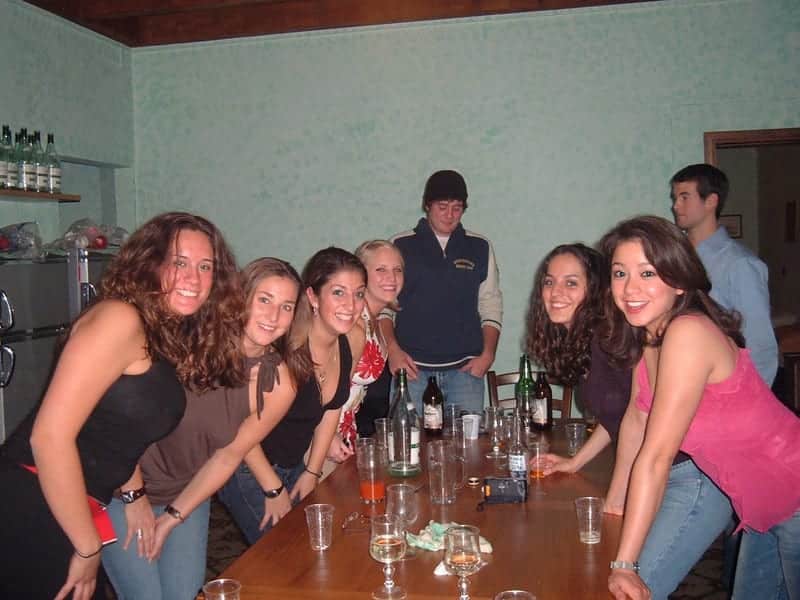
For years I had dreamed of studying abroad in Paris. But at the last minute, I decided to apply to be an RA my junior year instead — a resident advisor in a dorm. RAs had to commit to a full year, so I wouldn’t be able to study abroad at all.
Then the tables turned — I didn’t make the cut to be an RA. As I reeled in shock, I decided in that moment that having the year free meant I HAD to study abroad. But the Paris program was through another school, and it was too late to apply for the fall semester. If I had any chance of going abroad in the fall, it would need to be through one of Fairfield’s own programs.
At the time, Fairfield had study abroad programs in Galway, London, and Brisbane — but the most popular one was in Florence. Of those four, Florence was easily the most exciting and the most exotic to me. ITALY! I had to do it.
I ran around campus, securing transcripts and begging for recommendations, and applied the same day. I was accepted less than 24 hours later.
Florence was an incredible, life-changing experience. I wrote a 10-year retrospective about it here; it’s a great read. I lived in a huge apartment with eight other girls. We spent our weeks eating and partying in Florence and spent our weekends traveling to different places. Budapest, Interlaken, and Capri were some of my favorite spots.
And I did go to Paris after all — as part of my fall break with my friends. I was their navigator, translator, and tour guide.
While I was away, I kept a meticulous diary and wrote long, detailed emails to my friends about my adventures in Europe. People began looking forward to my weekly emails, and I began sharing them as blog posts.
I had no idea of its significance at the time, but I was in my first days of travel blogging — something that would become my full-time career six years later.
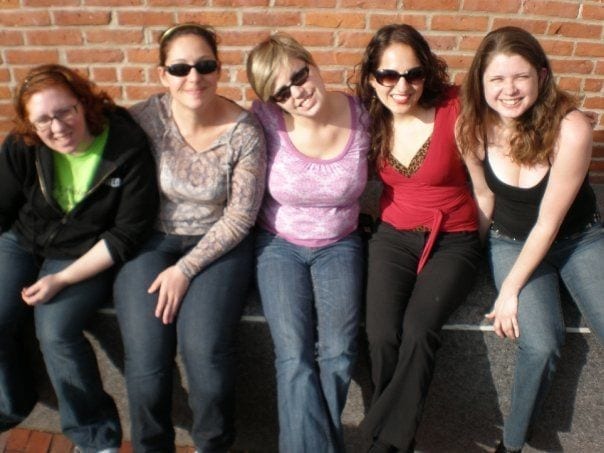
After graduating college, I got a job at a company in Boston. While my interviewer described the company as a marketing firm with celebrity clients, it turned out to be more of a call center (yes, with a few celebrity clients). We were a high-end concierge service for rich people; I was hired as a research assistant for the extra tough requests.
It was possible to have a lot of free time at this job if you did your tasks quickly, and I was a speed demon. I’d browse the web when I could, and I can’t remember how this happened, but I came across a website called Gone Walkabout. It was a collection of journals by a guy named Sean who had gone backpacking around the world for a year.
This guy spent a year traveling the world alone. Just because he wanted to.
My heart raced. I’d heard of entire families traveling together for a year, but a single person, alone? THE THOUGHT HAD NEVER EVEN CROSSED MY MIND. Keep in mind this was 2006. The internet was nothing like what it is today.
Right then and there, I knew I was going to do exactly what he did. I would save up for a year around the world.
Every day at work, I would go in, get my work done, and sneakily read more of Gone Walkabout, nearly jumping out of my seat with excitement. I vowed to do a similar route to his, starting in New Zealand and heading westward. I knew I had to visit Railay in Thailand, just like him.
At the same time, I became active on another travel site: BootsnAll. In those very early pre-travel blogging days, I hung out on the message boards with people like Beth of Beers and Beans, who went on to create the Speakeasy Travel Supply scarves that I share with you often, and Brooke from Her Packing List and Anne-Sophie from Sophie’s World. We talked about our favorite places, planned our future trips, and gave each other travel tips.
In the early 2000s, long-term solo travel was so uncommon among Americans that I had no idea it was even possible. That revelation broke my world open so wide that I knew immediately I would do the same.

The Grammar Vandal (via Boston Globe)
In 2007, Reebok ads appeared all over Boston reading, “RUN EASY BOSTON.” The lack of a comma drove me crazy and I decided to take a comma sticker and put it after the EASY.
I blogged about it, of course. I blogged about everything back then. But this seemed like such a good idea, it could be its own blog. The Grammar Vandal became my newest website.
Almost immediately, The Boston Globe contacted me, wanting to do a feature about me. I couldn’t believe it. After it was published, The Grammar Vandal went viral and I instantly had tons and tons of visitors.
I had no idea what to do with this fame except create more and more content. Every day would be a new post — I’d be changing grammar on signs, or musing about grammar rules, or ranting about something a celebrity said poorly.
After the Boston Globe interview, I was interviewed on NPR and for MSNBC.com (now NBC News). The blog got even bigger.
I knew I had a huge opportunity with this instant fame. But monetization didn’t even cross my mind, and something darker was happening — the fan mail was terrible. Almost every day, people would send me examples of bad grammar and would add, “That editor should be shot.”
“That editor should be shot”?! Are you actually advocating murder?
Suddenly I had built a successful blog with an audience I couldn’t stand.
I kept The Grammar Vandal up for a few years, but my heart wasn’t in it. As much as I enjoyed writing about grammar, I couldn’t deal with the mean, rude emails from my readers. Eventually, I stopped.
This taught me that I couldn’t blog about something I wasn’t genuinely passionate about. I began to entertain the idea of writing a blog about a subject I actually loved.

In the early post-college years in Boston, I kept up my blogging — still as Adventurous Kate on Blogger — and discovered several blogs by locals. One was called The Missus and was run by a woman a few years older than me. We commented on each other’s blogs and developed an online friendship.
The Missus worked in search engine marketing at a travel booking site. When it became time to hire an assistant, she reached out to me to see if I wanted to interview. “Anyone can learn SEO, but I need someone who can write, and I already know you can write.”
Yes. I was interested. I had been trying to get out of the call center job for months without success. And a travel company? How perfect!
I got the job, and a 25% salary bump. I was ecstatic — then because I had heard never to take the first offer, I emailed them asking for $5,000 more. (They offered $3,000 more and I couldn’t believe my luck.)
Those early days at the travel booking site were idyllic. It was a respectful professional environment with amazing coworkers and a fun, social atmosphere. I enjoyed my work and was eager to learn more. I even got to go out to business dinners at fancy restaurants like No. 9 Park.
In the early days, I did a lot of travel SEO content writing and was a natural at it. Later on, the job changed and became more about paid search, which I found incredibly tedious and boring.
My years of blogging for fun became my greatest professional asset, getting me noticed by a connection who gave me a great job. Learning the art of SEO content writing gave me one of the most important skills I used to build my career as a professional travel blogger.

Soon, my responsibilities at the travel booking site grew and I was put in charge of the company’s first social media accounts. Back then, social media was just Twitter and Facebook, there were almost no analytics, and their feeds were based on content curation more than anything else.
But this gave me an early opportunity to get to know the people on travel Twitter. Back in 2009, the entire conversation was happening on Twitter. As the human behind the accounts, I got to know who the big players were — and I used my knowledge to befriend them with my own profile, where I talked travel with them as well. When I eventually left that job, I messaged several of them privately and told them to head over to my personal profile.
This job gave me a reason to spend hours on social media and get to know the main players in the travel space, and those relationships I built with them led to them sharing my travel blog’s posts in the future.

I wanted to try my hand at freelance travel writing, and I combed Craiglook (a site that crawled all Craigslist sites) for writing gigs I thought I could do. One was for Boston nightlife. As a girl who hit the clubs every weekend, it was a perfect fit.
For $20 an article (they were just a few paragraphs long!), I’d write about Boston’s nightlife for sites like AOL Travel and TripVine. It wasn’t much, but eventually I started getting invited to different parties and events around the city.
Starting my freelance writing career while I worked a full-time job gave me a leg up when I eventually quit, giving me the connections and portfolio to earn a writing income once I started traveling.

Laptop Image via Pixabay
By this point, I had been blogging almost daily for seven years. Blogging wasn’t just a hobby — it was a major part of my life. I was ready to do something bigger.
After the success of The Grammar Vandal followed by my ambivalence for writing about grammar, I decided the next logical step was to start a new, more professional blog centered on my absolute favorite interest: travel.
It was the easiest decision of my life.
I began laying the groundwork in fall 2009 and AdventurousKate.com went live in late January 2010. I wasn’t one of the very first bloggers, but I was part of the earliest travel blogging community.
My plan was to write about my past travels and, when the time came, eventually write about my dream trip around the world. Thanks to Twitter and blogging, I made tons of new friends in the industry. People like Cailin, Stephanie, Michael, Lillie, Ayngelina, and Michael. Nearly a decade later, we’ve accumulated marriages, babies, breakups, career changes, and trans-continental moves, but I’m still friends with all of them.
Back then I blogged short posts daily. Monetization didn’t cross my mind. I wanted only one thing — to be one of the most popular travel blogs in the world. I wrote constantly; I networked with my travel blogger friends on Twitter; I became obsessed with this new and interesting community.
My old personal blog, the version of Adventurous Kate on Blogger (and then WordPress.com), became a relic of the past as I focused exclusively on the new self-hosted AdventurousKate.com.
This started it all.

The travel booking site was so wonderful in the early days — until the founders changed their strategy and decided that we needed to “get to 10X.” That day, they let go several longtime employees. Starting with some people I liked very much, including my blogging friend who had hired me.
Every few months, there would be another purge — two or three more people would be let go (we had something like 24 people in our office) — but bizarrely, they would be replaced with two or three new people doing essentially the same jobs. As you can imagine, it was terrible for morale.
I began searching for another job and landed one at an agency in the suburbs. I’d be doing paid search work for a variety of clients.
BOY was that fortuitous timing, as days later, I was told I no longer had a job. (I called the agency and asked if I could start a week early. They said sure.)
While I lucked out in missing only three days of unpaid work (who fires someone on a Tuesday?!), I soon learned that taking the job at Catalyst was a mistake. I hadn’t enjoyed paid search work at the travel booking site, but I loved the people — and now I was doing exclusively paid search work in a company with no social atmosphere whatsoever.
I was miserable at the agency. I hated every minute in the building and would spend my lunch hour listening to D’Angelo and Maxwell and Robin Thicke while walking all over the neighborhood.
So why didn’t I leave? I was terrified that if I went for a new career, I’d have to start over with an entry-level salary. I had moved into a more expensive apartment in downtown Boston and couldn’t afford that. I was terrified that I was stuck forever in an industry I hated.
That awful job was a blessing in disguise — it would be the push I needed to go after my dreams.

My going-away party in Boston
Around this time, I was tired of Boston and began weighing a move to New York. The logistics would be complicated if I moved without a job. I could transfer to one of the agency’s New York offices, but why would I want to continue in an industry I hated?
Day and night, I kept dreaming of traveling the world long-term. Soon enough, I realized that living in New York wasn’t my dream — traveling was my dream. I needed to move my travel date up a lot sooner.
But I wouldn’t have enough money for my dream trip, starting in New Zealand and moving on to Australia, Southeast Asia, India and Nepal, and westward to Europe. So what else could I do?
I could move to Korea, teach English for a year, and save a ton of money for my dream trip. But I had a close friend’s wedding to attend, and I knew that teaching in Korea would make it difficult to take the time off to come home. Not to mention all the other wedding activities.
Then it hit me. I didn’t have to do my dream trip — I could do a shorter trip in a cheaper destination.
Like Southeast Asia. For seven months. Southeast Asia was the place I wanted to visit the most anyway.
I would leave October 21, I decided, and I planned to work until October 15. I saved up $13,000 in seven months. I booked a round-trip ticket to Bangkok. My lease ended on August 31 and I moved into my mom’s house for the last few weeks.
I gritted my teeth through the workday. October 15 was too torturous; I decided to stick it out until October 1. I didn’t last. On September 14, 2010 — a day I celebrate each year — I picked up my belongings and walked out with my belongings, never to return.
These months were among the hardest of my life — not only was I working a job I hated, I was blogging in my free time and doing a ton of freelance work, only sleeping four hours on weeknights. I was also barely eating and lost 20 pounds in a very unhealthy way. I spent as little money as possible. Living this way made the coming trip even sweeter.

It sounds crazy now, but back in 2010, few people were blogging about Southeast Asia exclusively and few women were specializing in solo female travel. By focusing on these two areas in this time, I was able to differentiate myself from other travel bloggers, who were mostly doing RTW trips on a budget or traveling part-time.
Blogging was SO different back then. I miss it. Blogs were narrative-driven, people commented like crazy, you didn’t have to worry about Instagram and Pinterest because they didn’t exist. And if you were making money from your travel blog, you were selling text links.
I remember those early days in Southeast Asia so clearly. I didn’t sleep a wink the first night — I got up at dawn, went to the Grand Palace and Wat Pho, and came back to my hostel to write about them. Writing about real-time travel felt so unnatural at first, but soon I found my groove.
This was the ideal way to start my travels — I was experiencing an interesting, cheap region and educating women on what it was like to travel Southeast Asia solo.

Most people think quitting my job to travel the world was a ballsy move — but I think what I did the following year was even more terrifying.
After coming home from my seven-month trip and being present for my friend’s wedding, I had found myself in an unexpected situation: with a new English boyfriend I had met in Vietnam.
He was coming to visit Boston in July, so it made no sense to get a job before then. I got offered trips to Sayulita, Mexico, and San Antonio, Texas. I hung out at home and continued to blog; he visited; all seemed good. Shortly after that, I was invited to a travel blogging conference in Austria in late August, and it seemed like a great way to tie in a visit to my boyfriend.
I went to England. I went to the conference in Austria, and visited Germany and Liechtenstein for the first time (the latter as their hosted guest). I got invited on two sweet press trips: Emilia-Romagna, Italy, and Jordan. I added a side trip to Turkey after Jordan and planned for Portugal and Spain in the winter.
It made no sense to go home. Europe was great. I had a community of travel blogger friends. Things were good with my boyfriend. I stayed.
What I didn’t realize at the time was that Europe was the best place I could have been — the travel blogging industry was far more advanced here than anywhere else. There were more press trips, more conferences, and more PRs that took blogging seriously. I had put myself in a very strategic relationship-building position.

Those early years were tough. I was in love with my work and addicted to the freedom, but I was barely getting by financially. My income came from text links, poorly paid freelance writing, and the occasional odd writing or editing gig. I lived off press trips and generosity.
I hit a breaking point during Chinese New Year in 2014, while I was in Boracay. That day, my most lucrative writing gig, a steady $1500 per month, disappeared. In the coming weeks, I wrote a post called How to Start a Travel Blog, linked to some affiliates for web hosting, and forgot about it.
Google updated and I suddenly started getting tons of web hosting commissions. By the spring, I was making thousands of dollars per month off that one post alone. I did so well that my highest-earning affiliate massively increased my commission.
Somehow I had cracked the code. Finally I had the job I loved — and money as well.
It didn’t last. Within a few months, virtually every other travel blogger copied my post, and in a few years I was pushed out of the top rankings. But I had laid the groundwork for other successful posts. Plus, at this time, I started getting paid campaigns on a regular basis.
I should have gotten into affiliates years earlier — but I was still ahead of the game. Building a passive income took a lot of pressure off me and allowed me to continue creating content that made me happy.

In early 2016, I moved to New York. This decision was crazy in so many ways — if you can work from anywhere, why move to a cold, expensive city that makes life so hard for you?
I did it because I wanted to. After moving abroad twice for relationships, finally I was choosing a place for me alone. And also because my sister and best friend were here, among other friends. But despite the high cost of living, being a travel blogger in New York provided lots of other advantages.
I got some opportunities in part because of my location. My campaigns with Austrian Airlines, ANA, Kenya Airways/Fairmont Kenya, and Guyana Tourism, as well as several influencer opportunities, would not have happened if I hadn’t been based in New York. Brands will always fly you from New York because it’s so well-connected.
New York is the center of the travel industry, and it’s amazing that I can meet for coffee with different PR agencies whenever I feel like it. New York has industry events like Travel Massive, IMM, and the New York Times Travel Show, where I’ve spoken annually since 2015. There are always events being thrown by different tourism organizations. I get offers for free Broadway shows, restaurant openings, and all kinds of events.
But the most important thing is the city’s work culture. People in New York work extremely hard and it encourages you to work even harder. I wouldn’t have had that same kind of motivation if I had moved to a digital nomad hotspot where people work only enough to get by.

What does success as a travel blogger look like today, in 2019? Everyone’s definition is different. For me, I live in Manhattan and have a large apartment all to myself. My sister lives a short walk away, my best friend lives a subway ride away, and I have lots of friends in the city. My family and friends in Massachusetts are a short train ride away, and I’m a loving auntie to two sweet little boys, one in New York, one in Massachusetts.
I’m in New York about 75% of the time and I travel the other 25%. I have friends around the world. I work out in the mornings and work in the afternoons and evenings. I love exploring New York, going to literary events, obsessing over politics, Zumba classes, taking long walks in Central Park, and spending time with friends. I don’t work while traveling anymore; I prefer separating those aspects of my life these days.
Is my life perfect? HELL NO. There are LOTS of things I’d like to improve; I have worries that keep me up at night. But it’s a good life, and it’s a life that I built for myself. It’s worlds away from when I was on a sweatbox of a train in Bulgaria, down to my last $200 and owed $9,000 from late-paying vendors, and sobbing my eyes out. Or working in that terrible office in suburban Boston, marking a line whenever 15 minutes had passed.
I think when you look at the events of my life, themes begin to emerge. Three major things:
1. I had a privileged upbringing that put me on a much higher footing than many of my peers in terms of education, work ethic, and opportunity.
2. I grew my lifelong loves of writing, geography, and technology into obsessive storytelling, travel, and website-building.
3. I made a lot of smart decisions at the right time, even when I didn’t realize it at the time.
I also think it’s equally important to examine what I didn’t do. Today, most people start travel blogging because they want to make money and get travel comps. I was never in that position because making money and travel blogging comps didn’t exist in 2010. Hell, when I started my travel blog, I thought the only way to make money was to get a book deal or TV deal.
I didn’t look to replicate the success of others because I was one of the originals. Almost everything I did was based on instinct, and I had already developed my voice from seven years of near-daily blogging.
I started this career because it was my favorite hobby. I’ve kept it going since because I still love it. That is my greatest motivation — work that I greatly enjoy, and knowing I can help women along the way.
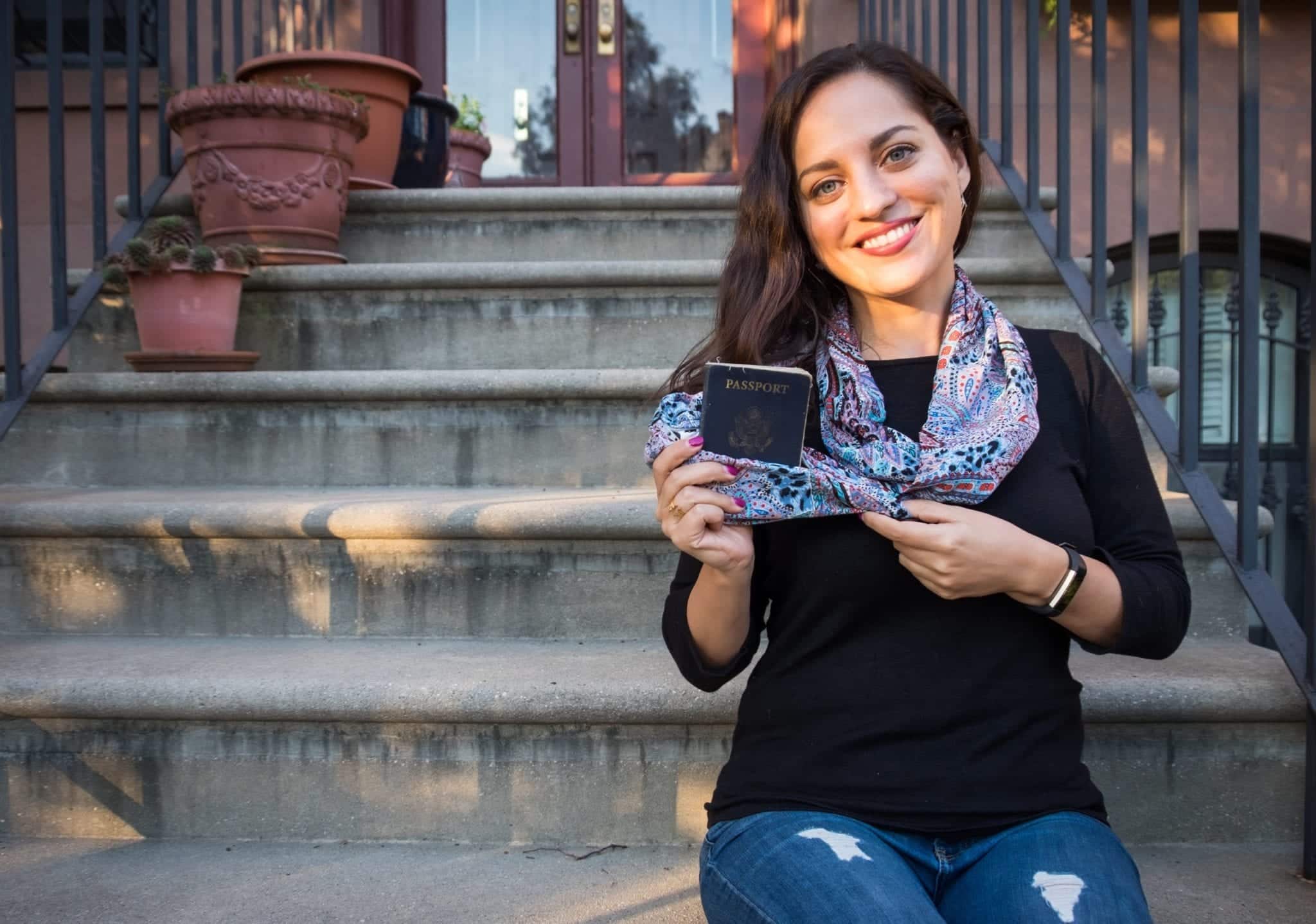
Unfortunately, you can’t do it exactly the way I did. So much of my success comes down to timing, from being a teenager when Angelfire was at its height to being a college student when blogging was in its infancy to starting a travel blog among the first generation.
But I do have advice for parents or teenagers or college students who are looking to glean lessons from my life:
Cultivate your interests and lean into them. I grew a career that I’m passionate about because I had been spending years and years preparing for it — without even knowing it. My obsessions with writing, travel, and technology eventually knit together into travel blogging. They say it takes 10,000 hours of practice to master a subject, and I had definitely been blogging for 10,000 hours for fun before I even started Adventurous Kate.
Get involved in technology from a young age. Learn to code. Learn to build websites. Master a social network and content creation. Learn cutting-edge techniques of photography and video production. When you put in hours developing these skills, you’ll be in a better position than your peers. Of course, be sure to have a healthy amount of time away from technology, too. It’s good for your brain.
Forcing yourself to take a leap can be the greatest motivation. I wouldn’t have worked nearly as hard to succeed at blogging if I hadn’t quit my job, or moved to Europe when I was broke, or lost my plum freelance writing gig, or moved to expensive New York. Had I taken the easy way out, I could still be making $2,000 per month, drinking every night in an expat hangout, and wondering why my blog was getting less and less popular.
I know that my life will continue to evolve — I might not always be a blogger, but I know that travel and storytelling will always be part of my life. I’m looking forward to the next step, and the step after that, and the step after that.

The post How I Became a Successful Travel Blogger — My Smartest Decisions appeared first on Adventurous Kate.
2019 World Golf Championships-Dell Technologies Match Play Preview Dates: March 27-31, 2019Where: Austin Country Club, ... Read more.
The post 2019 World Golf Championships-Dell Technologies Match Play Preview appeared first on GolfBlogger Golf Blog.
Corales Puntacana Resort and Club Championship Winners and History The Corales Puntacana Resort and Club ... Read more.
The post Corales Puntacana Resort and Club Championship Winners and History appeared first on GolfBlogger Golf Blog.
Below you will find the groupings for the WGC Match Play 2019. Within each group, ... Read more.
The post Groupings and Brackets For The Dell WGC Match Play 2019 appeared first on GolfBlogger Golf Blog.
TaylorMade TP5 Pix Golf Balls The TaylorMade TP5 Golf balls use multi colors graphics to ... Read more.
The post TaylorMade TP5 Pix Golf Balls appeared first on GolfBlogger Golf Blog.
WGC Match Play Winners And History In 2016, the WGC Match Play acquired a new ... Read more.
The post WGC Match Play Winners and History appeared first on GolfBlogger Golf Blog.
What if I told you that, when it comes to where you live, you can have your cake and eat it too?
What if there was a way for you to live in a highly desirable area — San Francisco, Chicago, New York — but you never had pay rent or a mortgage payment?
And before you jump off this page, thinking I have some crazy trick up my sleeve, I promise you, I have nothing to sell at all!
In fact, you and I are probably a lot of like. At the time of this writing, I’m living in Chicago — Rogers Park to be exact — and lovin’ my life in the big city.
There is always something going on! I’m literally a 5-minute walk to the beach on Lake Michigan. I have all the ethnic cuisine I could ever want at my fingertips. All in all, I've found a community here like I’ve never experienced before.
The world is in my backyard: There is so much culture, diversity, and innovation everywhere you look.
Life is truly incredible here, and my family and I are happier then we’ve been in a long time.
There’s just one, tiny problem: My rent is $1,450 a month!
This is, of course, insanely expensive! But here’s what’s even crazier: $1,450 per month is considered pretty cheap as far as big cities go.
Back where I lived previously, in the San Francisco Bay Area, my home was a 600-square-foot apartment, in a really rough part of San Jose. Homeless people routinely ate out of my garbage can. People were selling drugs on the street corners.
My rent there was $1,800 a month, and these days, I would be paying about $2,500+ for the exact same place.
Given how residential values have skyrocketed in the most popular urban areas nationwide, the possibility of ever owning a house in one of these major cities is a pipe dream for many.
Add in the continual rise of property taxes each year (mostly a Chicago problem) with increases in gentrification, and home prices just keep going up and up and up, with no clear end in sight.
When I spoke with a lender to explore some options here in Chicago, he told me I needed to shoot for a purchase price of at least $500,000, which translates to an average monthly mortgage cost of $2,600 plus $500-$1,000 in property taxes per month!
That’s over $3,000! I just can’t justify that; I’ve simply been ruined to expensive real estate due to my years as an investor.
So, the question becomes: What do we city-lovers do?
We want to be financially wise, invest our hard-earned cash carefully and wisely, and save for our future. But who wants to live in the middle of Nowhere USA in order to do it?
I don't. I’ve tried it, but it’s simply not for me. Chicago has to be a major part of me and my family’s life in the future.
I was determined to figure out how to do life in the big city, while still being financially savvy — a tough challenge, to say the least — and one for which I've found a solution.

“House Hacking” is essentially a way for you to use creative real estate tactics to extremely lower or, as I plan on doing, completely eliminate your monthly housing costs.
The term has been widely popularized by our friends over at BiggerPockets and is typically talked about in the context of buying a 2-to-4-unit apartment building, living in one of the units, and renting out the other(s).
This is one type of house hacking I’ll be covering in more detail shortly, but there is actually more than one way to do it.
In my research, I discovered there are actually three different ways you can hack your mortgage:
To figure out which method was the best fit for me, I interviewed a few experts that specialize in each method, and I'm bringing you along for the ride with me.
Below, you'll find each interview I conducted, along with an overview of each strategy as well as their pros and cons.
Without further ado, let’s dive in!
Interview with Lucas Haul, Cozy.co and Landlordology.com
There are three primary ways you can go about house hacking with roommates.
These methods of house hacking work the best for very desirable and expensive areas. This is because these are the markets where people are happy to pay $500 – $1,000 for a room with shared common areas.
Let’s look at another Chicago-based example of what this can look like:
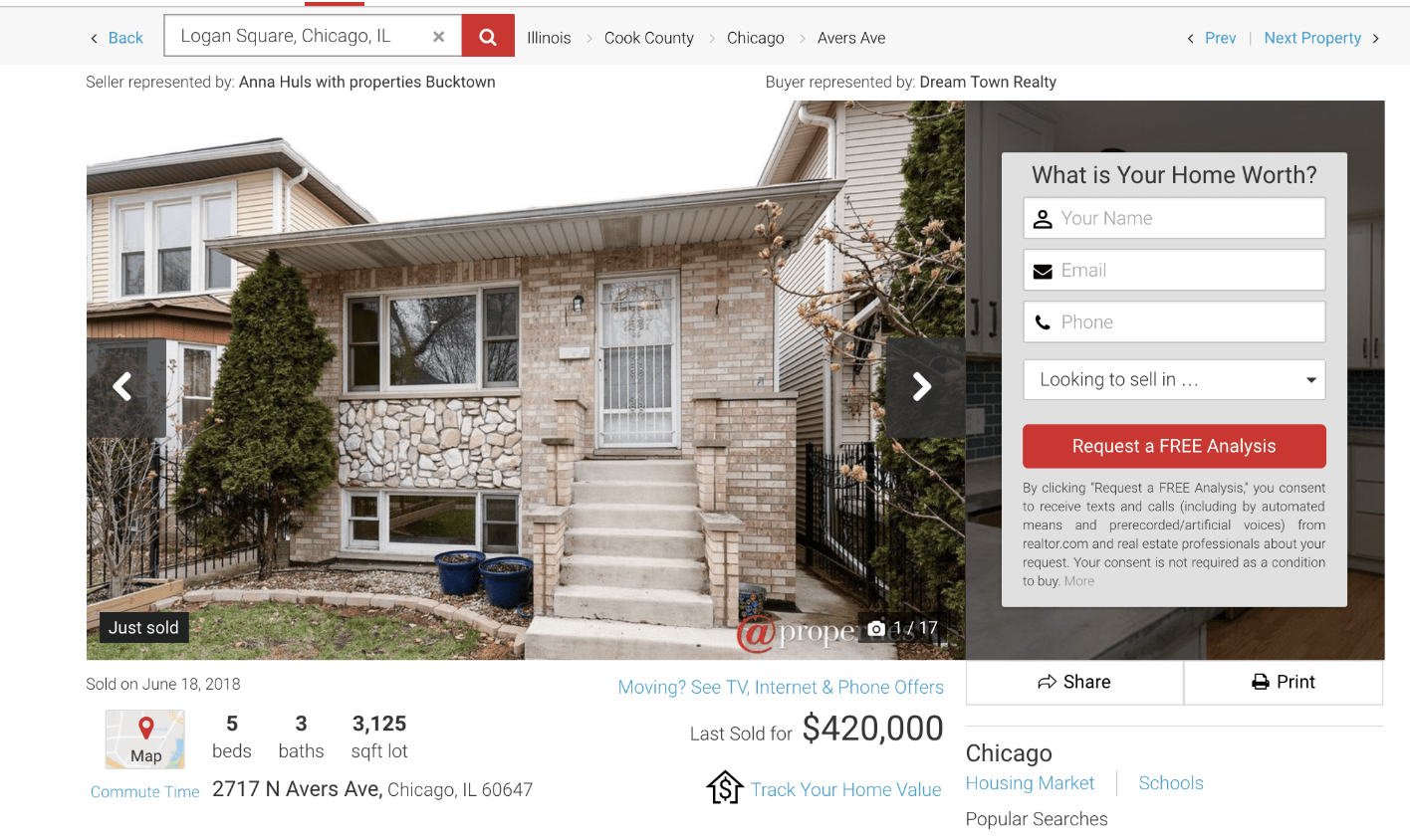
This property in Logan Square (an extremely hot neighboorhood in Chicago) recently sold for $420,000. It has five bedrooms.
If we use the mortgage calculator again, we’re looking at $2,905 per month in housing costs:
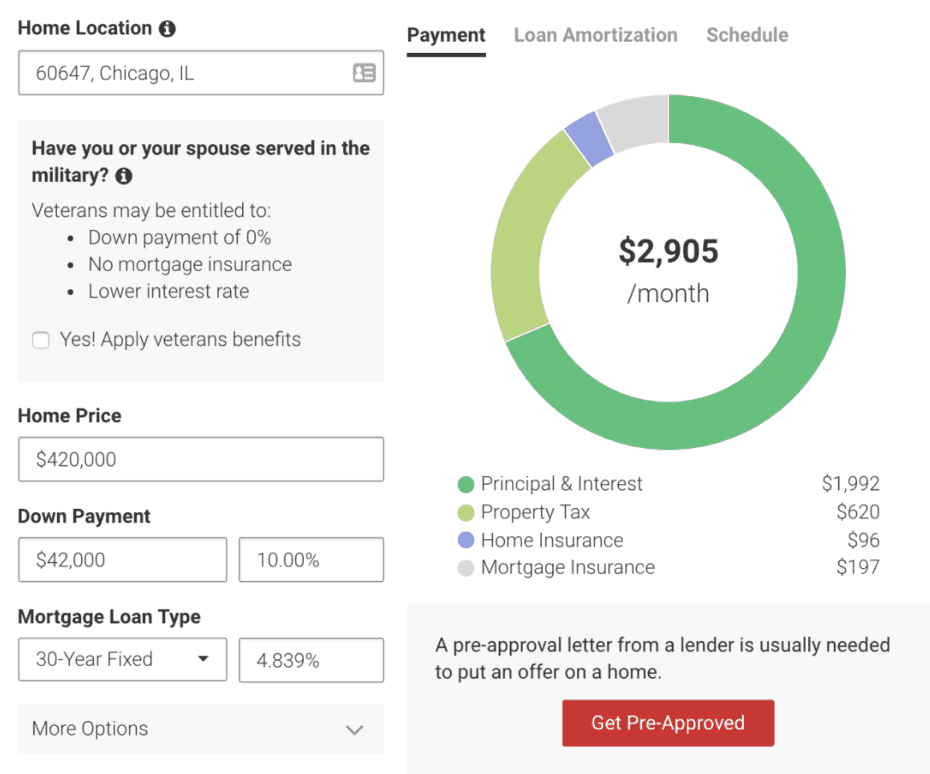
(Note: Different loan programs, with different down payment amounts, may increase or decrease the monthly mortgage costs. Above, I’m using 10% down as a general ball-park for the sake of example).
If we look at Craigslist to see what other people are renting their rooms out for in Logan Square, we get about $700 per room:
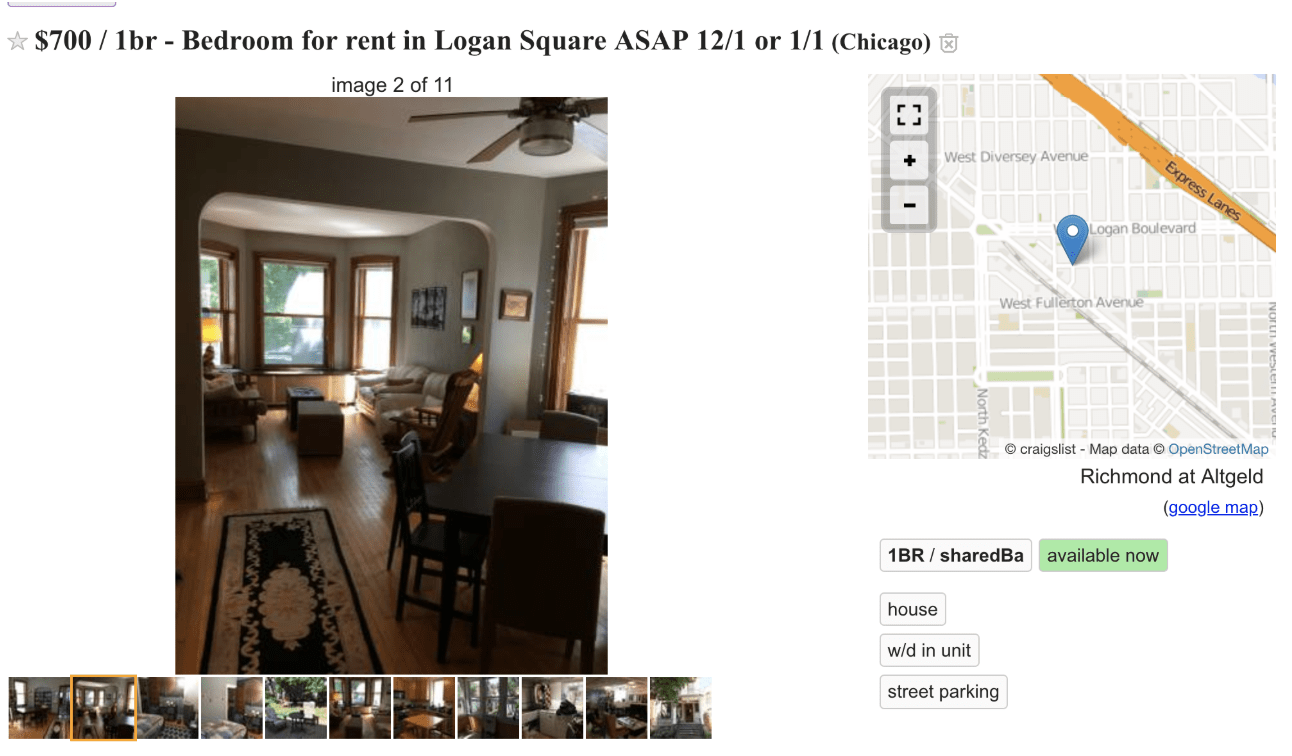
If we have four out of the five bedrooms rented (because, obviously, you need a bedroom for yourself) at $700 per room, that brings in $2,800 per month ($700 * 4 rooms = $2,800).
Again, our mortgage costs are $2,905, so that means we still have to come up with $105 per month to cover the rest of this monthly payment.
If all you had to pay was $105 per month in housing expenses and you got to live in the heart of a massively desirable city, would it be worth it?
I think so!
Now, don't forget: You're still on the hook for maintenance costs associated with the house, but this is the same risk you face with any kind of home ownership.
The upside when you house hack with roommates is that because you’re saving so much money per month on your mortgage, you can now easily save for these unexpected events.

House hacking with roommates can be a great option if you’re young, single and just getting started in life.
You have the potential to live in a part of a city that is highly desirable (and otherwise, very expensive) for little to no money each month.
If your roommates are friends and people you like being around, living in the community while you’re young can be an incredible way to create lifelong memories.
I think this strategy is the best fit for young adults, but I wouldn’t recommend it for families (though, it could still work if you did option 2 or 3, listed above in the overview).
Interview with Ben Leybovich, JustAskBenWhy.com
What I love about house hacking through Airbnb is that it gives you the best of all worlds.
You get to have a nice, upscale, single-family residence while living in a great area AND deciding whether or not you want to have a tenant.
Here's the short and sweet version of how this works:
If you’re living in a major city, there are always people looking for short-term, vacation-like rentals.
You can choose to keep it booked year-round or if you want friends to come and stay with you (or if you want a weekend with no tenants), you can simply adjust the availability on Airbnb.
It gives you the most control, while still massively cutting down on your mortgage costs.
Let me share an example that Ben used to show how this works, in his book: House Hacking: The Only Real Estate Investing Strategy You Need to Build Wealth, Live for Free (or almost free), and Make Money Through Homeownership.
He ended up buying a beautiful, three-bed, two-bath house in the Chandler area of Arizona for $355,000. It came with a separate casita off of the main house. His monthly expenses came out to $2,050.
After running all the numbers, factoring in months of high vacancy, he determined that his average cash flow from renting out the casita on Airbnb and VRBO is $1,300 per month.
Do the math and you'll see that he gets an incredible, private house with a pool in one of the most desirable areas in Arizona — and he only has to pay $750 per month.
Can it get much sweeter than that?
Interview with Scott Trench, BiggerPockets
Real estate can arguably be divided into two categories: commercial and residential.
Now, if we get technical for a moment, YES – you can make money from residential properties. Realtors, house-flippers, and landlords do it all the time, and, to be fair, you could live within a commercial building too (like living in one of the apartments of a 100-unit complex).
To keep things simple, though, residential properties are for residing and commercial properties are for conducting business.
In the real estate mortgage industry, any property that has four units or less is considered residential and qualifies for a conventional home mortgage.
Any property that has five units or more is considered commercial and would require a commercial loan.
When it comes to house hacking, if you acquired a residential property that was between 2-4 units, you could qualify for a conventional residential mortgage, even though this is technically an income-producing asset.
This is actually a big deal because these loans are relatively easy to acquire and there are a lot of low-money-down options, like the 3.5% FHA loan, and other “down payment assistance” programs, that, if you qualify for, could have you securing a mortgage for little to nothing out of pocket.
What’s more, if you bought the property at the right price, you could potentially live in one of the units and have the rents from the others cover most, if not all, of the monthly mortgage, insurance, and property taxes.
Let me provide a Chicago-based example using Realtor.com: A 4-unit building just sold in the up-and-coming McKinley Park in the northern part of the South Side for $308,000:
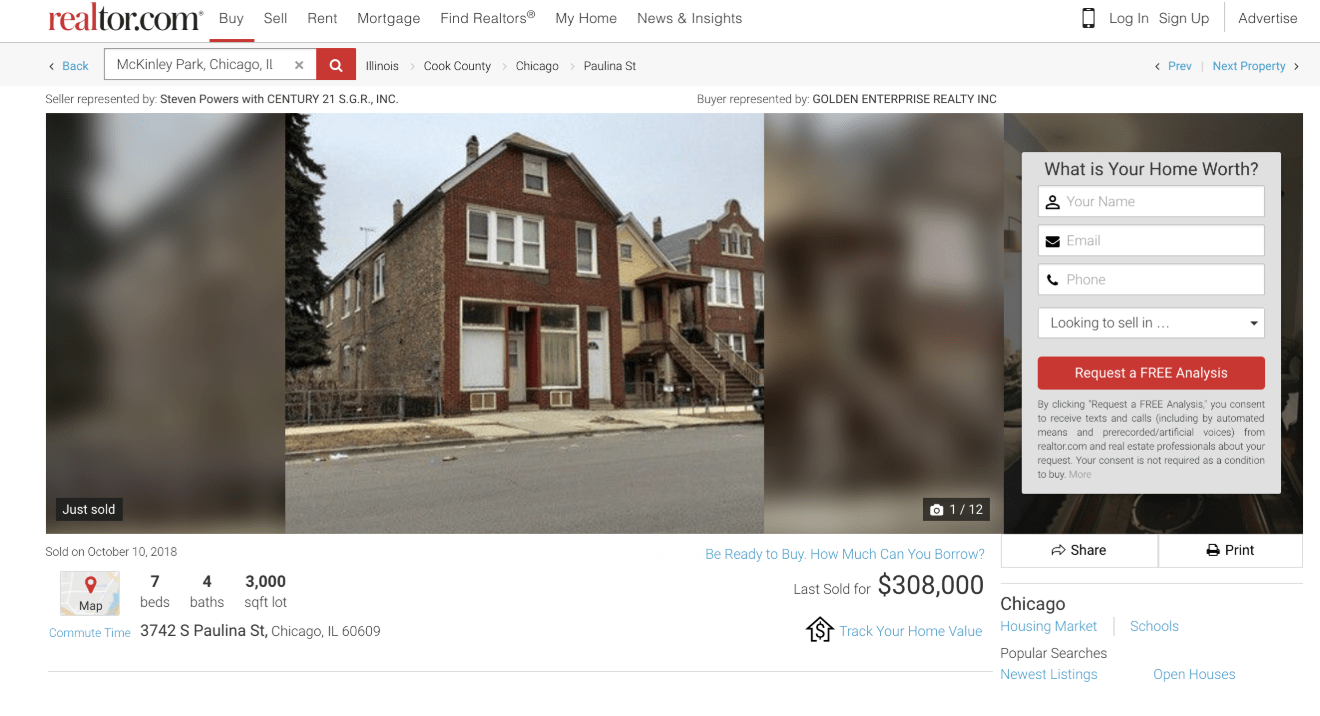
According to Realtor.com’s mortgage calculator, this property would cost about $2,200 per month, taxes and all:
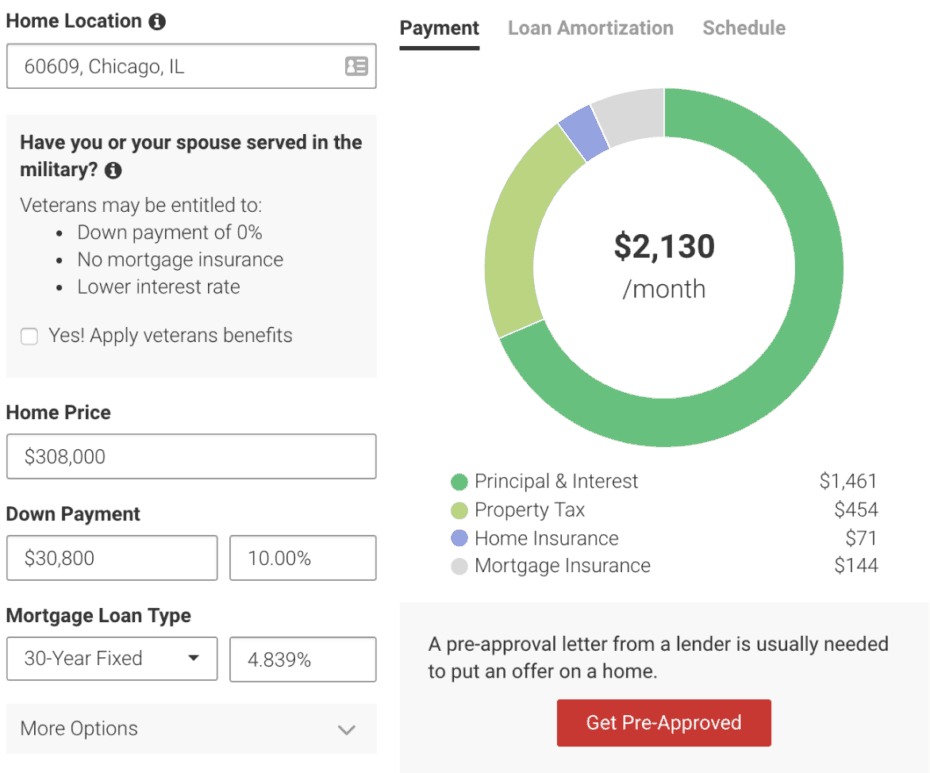
(FYI: This is cheaper than most places in Chicago because it’s up-and-coming and crime is higher).
If we use Rentometer to determine the average rent prices for a 2-bedroom apartment in the area, we’re looking at around $1,200 per side:
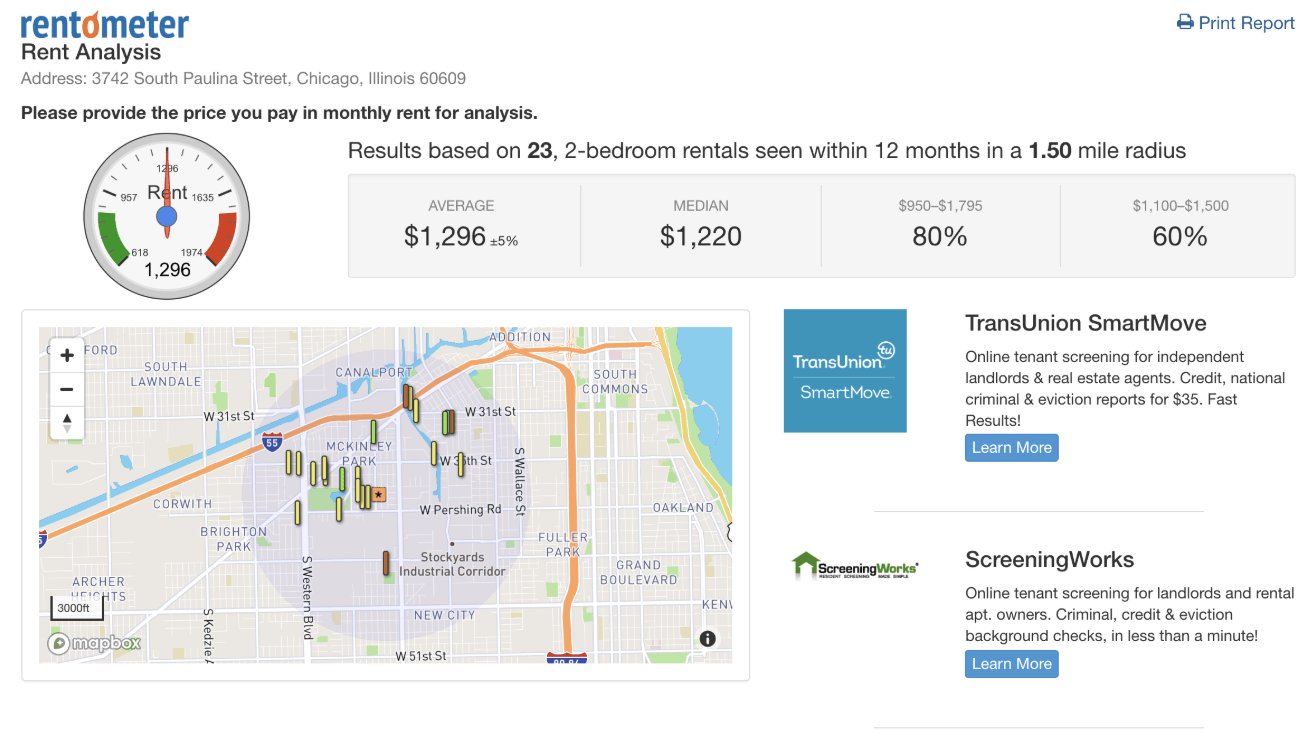
If we rent out three of the units, that’s $3,600 in gross monthly income ($1,200 * 3).
So, if our mortgage costs are around $2,200, that means we’re seemingly ahead by $1,400, per month!
In reality, because you’re the owner of this building, every time a water heater goes out or a toilet stops working in one of the rented units, it's your problem to pay to fix it, so this $1,400 isn't the most realistic portrayal of what's actually available.
In buy-and-hold real estate, there is a common rule of thumb called the 50% Rule. This rule says that,
Your ongoing maintenance costs are going to average about 50% of your gross rents.
So, for our example, that would work out to be $1,800 ($3,600 * 0.50 = $,1800).
I think the 50% Rule is a little extreme. You might be okay with less, but it’s best to be conservative all the same.
Before we move on, I want to address one more thing.
Let’s say the property you were looking at didn’t have as good of numbers like the one I’m using in this example. Let’s say, after we factored everything in, you were still on the hook for $500 per month.
If you only had to pay $500 every month, but you could live in a major city that you loved… would it be worth it?
I think so! Spending $500 for a nice apartment in a major city that you love living in AND is giving you ownership of an appreciating asset, is a huge win.
Of course, appreciation is never a guarantee, but in a major metropolitan city, it’s a lot more likely than in rural markets. That means over time, you might make some big bucks from your property.
There is a reason why house hacking with small apartments is the most commonly known method.
There are a lot of upsides — the biggest being that you are the owner of an income-producing, appreciating asset that will continue to produce wealth as long as you have it (assuming you bought it correctly).

So, after all this research, what did I decide to do?
First, let me explain my thinking process.
Originally, I thought a single-family house with an in-law suite would make for a perfect Airbnb rental.
You see – my wife wants to live in a nice house without having to share a wall with our tenants – and I thought a detached, income-producing in-law suite would be the best of both worlds.
Not to mention, with the extra income from this Airbnb unit, it would MASSIVELY impact our ability to cover a higher mortgage payment on a nicer property in a more desirable part of the city.
The problem that arose, though, was with Chicago itself.
Chicago has the second-highest property taxes in the nation (outside of New Jersey), and they seem to be increasing year after year.
There are some pretty big issues with the state of Illinois, and though most of it is over my head, I can clearly see some warning signs that suggest Chicago’s economy is going to get worse before it gets better.
Crime (especially on the Southside) is among the worst in the nation. My own sister-in-law was recently robbed at gunpoint and beaten until unconscious – and this was on the “safe” side of the city at 9:30 in the morning!
I couldn't help but think – this could have easily been my wife or child, and as much as I love this city, I don't know if I can swing living day-to-day with that kind of risk.
Ultimately it came down to two choices:
This wasn’t the most ideal option because, let's face it, renting feels like flushing dollars down the toilet.
Nevertheless, we don't know exactly what the best option is right now and renting would be a good way to take the pressure off so we could think rationally while in transition.
Most people don't realize that Northwest Indiana is only 45 – 60 minutes outside of downtown Chicago.
I currently live in the most northernmost neighborhood within the Chicago city limits called Rogers Park.
Right now, it's a 35-40 minute drive to downtown Chicago – and that’s within the city limits. So, moving to Indiana might be a way to “Have our cake and eat it too,” so-to-speak: more affordable, safer and still close enough to experience all the benefits Chicago has to offer.
There are still some major drawbacks in this option, however, namely that my in-laws (who live with us a portion of the year) would have to commute 45 – 60 minutes to work… and they don't really know how to drive.
My wife's family is from Kazakhstan and they prefer to work among the Central-Asian community here in Chicago.
Also, our church community would be a 45 – 60 minute commute as well, and that puts a big strain on the relationships that we cherish there.
We decided we're going stay in the Chicago area and continue renting for now.
There are just too many moving parts for us to make an immediate decision. Instead of being under pressure, we're just going to stay flexible and see how our life (especially with our soon-to-be newborn) turns out.
We're considering moving to a Chicago suburb that is closer to our church community and that's slightly safer, but for now, we're going to renew our lease and put our attention on growing my budding land-business.
Once we're making the kind of money we're striving toward, perhaps we'll just build a mansion and not worry about house-hacking at all!
The post House Hacking: The Official Guide On How to Live (Almost) Mortgage Free appeared first on REtipster.